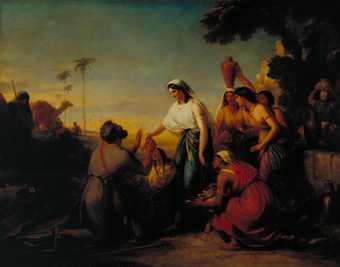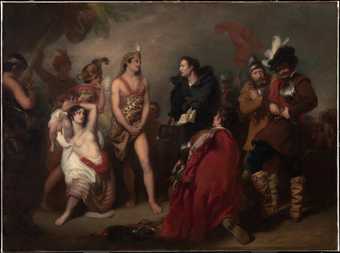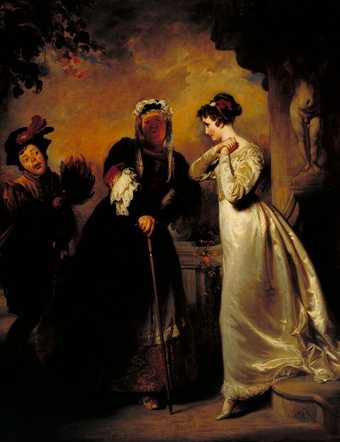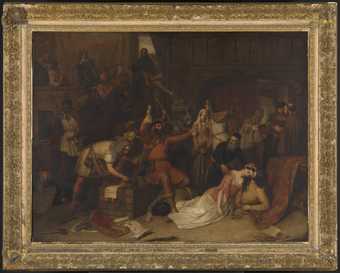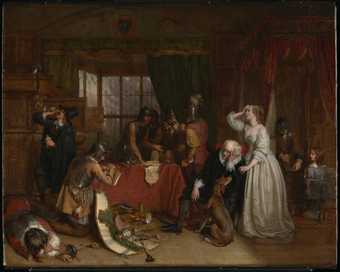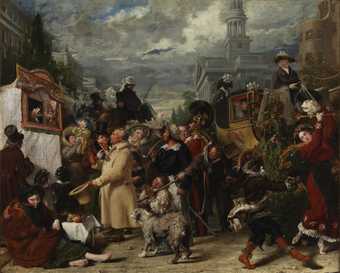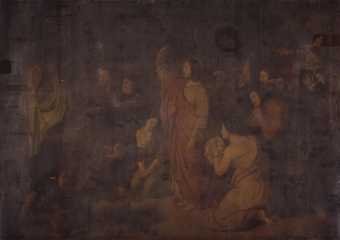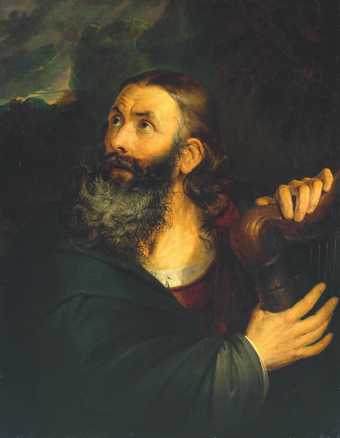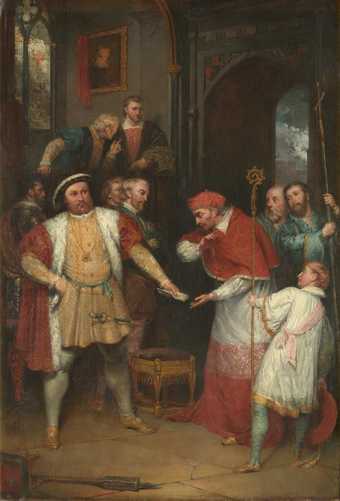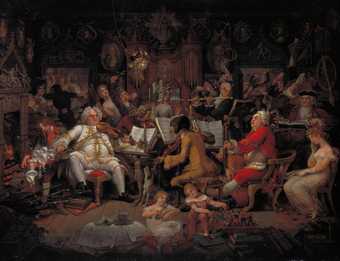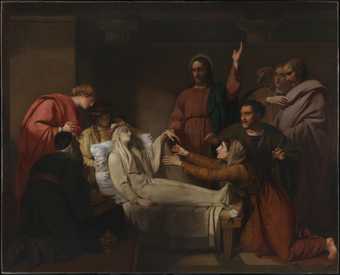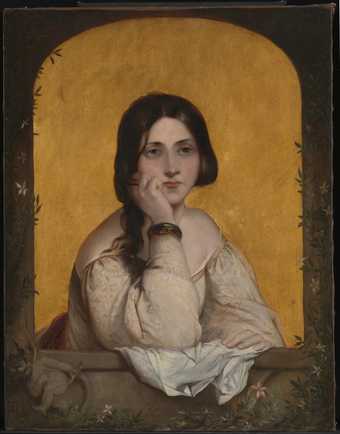
- Artist
- John Simpson 1782–1847
- Medium
- Oil paint on canvas
- Dimensions
- Support: 733 × 562 × 18 mm
- Collection
- Tate
- Acquisition
- Presented by Robert Vernon 1847
- Reference
- N00382
Summary
This life-size study of a model’s head and shoulders evokes a tradition of heroic and divine imagery stretching back to antiquity. The far-off gaze would conventionally suggest philosophical reflection or moral aspiration, while the heavy red cloak billows out like the costume of a saint in seventeenth-century religious art.
The painting is closely linked to John Simpson’s larger subject painting The Captive Slave 1827, which reappeared on the art market and was purchased by the Art Institute of Chicago in 2008, showing the same sitter but in half-length format, manacled to a bench. That painting was exhibited in London in 1827 accompanied by lines from William Cowper’s anti-slavery poem ‘Charity’ (1782). Although the slave trade had been made illegal within the British Empire in 1807, slavery continued in British colonies until the 1830s and remained a hugely divisive political issue. Simpson’s paintings can, therefore, be interpreted as interventions in an ongoing dispute about race and slavery.
The present painting was shown as ‘Head of a Black’ at the exhibition of the British Institution in 1827. Although exhibited originally as an anonymous figure, the model appears to be the American actor Ira Frederick Aldridge (1807–1867). He had come to Britain in 1824 and made his debut on the London stage in 1825. In the face of much racial prejudice he took on a wide variety of roles and established an international reputation. He was painted by several artists in the early stages of his career, including John Jackson, Henry Perronet Briggs and James Northcote.
The painting was probably purchased at the time of its exhibition by the important patron of contemporary British art, Robert Vernon. He presented his collection to the nation in 1847. When the work was engraved in the Art Journal in 1853, it was given the title of ‘The Negro’ and mistakenly attributed to ‘W. Simpson’ (The Art Journal, vol.9, 1853, p.312). The accompanying text imagined it as a suitable illustration of the lead character in Harriet Beecher Stowe’s recent and hugely popular novel Uncle Tom’s Cabin (1852): ‘for it is a fine noble face, notwithstanding its African origin, and its melancholy expression, as if the spirit could never, even though schooled into submission by the principles of Christianity, become inured to the state of degradation into which the body is subjected’. This commentary, connecting the image to one of the defining texts of modern racial attitudes and praising the physical beauty of the sitter in a highly qualified way, conveys an ambiguous appreciation of the work in line with dominant Victorian attitudes to race. The painting was kept among the ‘Miscellaneous Works’ in the basement of the National Gallery in the later nineteenth century, and it appears to have been mainly in storage since being transferred to the Tate Gallery in 1919. Its potential historical importance has subsequently become clearer with the re-appearance of The Captive Slave and renewed interest in the life and career of Aldridge.
Further reading
Paul Gilroy, Picturing Blackness in British Art 1700s–1990s, exhibition pamphlet, Tate Gallery, London 1995, no.13.
Jan Marsh (ed.), Black Victorians: Black People in British Art 1800–1900, exhibition catalogue, Manchester City Art Gallery, Manchester 2005, no.88.
Martin Postle, ‘The Captive Slave by John Simpson (1782–1847): A Rediscovered Masterpiece’, British Art Journal, vol.9, no.3, 2009, pp.18–26.
Martin Myrone
September 2013
Does this text contain inaccurate information or language that you feel we should improve or change? We would like to hear from you.
Display caption
This painting is believed to depict the African American actor Ira Aldridge (1807–1867). He came to Britain in 1824, making his debut in London the following year. Aldridge is shown gazing upwards, as if inspired, perhaps in one of his roles. He may have been modelling professionally or this image might be part of his publicity campaign. When the picture was exhibited in 1827, Aldrige was rising to fame as the first Black Shakespearean actor performing in Britain. He challenged racial prejudices, giving speeches about the injustices of slavery on closing nights. This painting was perhaps a statement of support for abolition.
Gallery label, May 2023
Does this text contain inaccurate information or language that you feel we should improve or change? We would like to hear from you.
Catalogue entry
John Simpson 1782–1847
Head of a Man (Ira Frederick Aldridge?)
Exhibited 1827
Oil paint on canvas
733 x 562 mm
Presented by Robert Vernon 1847
N00382
Ownership history
Probably purchased from the artist in 1827 by Robert Vernon (1774–
1849), London, by whom donated to the National Gallery, London, in 1847; transferred to the Tate Gallery in 1919.
Exhibition history
References
This study of a black model’s head and shoulders evokes a tradition of heroic and divine imagery stretching back to antiquity. The far-off gaze would conventionally suggest philosophical reflection or moral aspiration, while the heavy red cloak or coat, pulled back with the white shirt underneath to bear the sitter’s muscular chest, billows out like the costume of a saint in seventeenth-century religious art. But while the image aspires to timeless grandeur, it also represents a recognisable individual and connects with then-current political debates about the abolition of slavery.
The painting is closely linked to Simpson’s larger subject painting, The Captive Slave which reappeared on the art market and was purchased by the Art Institute of Chicago in 2008 (oil on canvas, 127 x 101.5 cms, Restricted gift of Mary Winton Green, Dan and Sara Green Cohan, Howard and Lisa Green and Jonathan and Brenda Green, in memory of David Green, 2008.188).1 This shows the same sitter with a bared chest and his face raised in the same way but facing in the other direction in a half-length format revealing the figure clothed in an orange cowl and visibly manacled to a bench. That painting was originally exhibited in London and Liverpool in 1827 and 1828, accompanied with lines from William Cowper’s anti-slavery poem ‘Charity’ (1782). Although the slave trade had been made illegal within the British Empire in 1807, slavery continued in British colonies until the 1830s and remained a hugely divisive political issue. Meanwhile, racial prejudice and stereotyping abounded on both sides of the debate, reflecting deeply entrenched European views. Simpson’s paintings can, therefore, be interpreted as interventions in an ongoing dispute about race and slavery, presenting relatively dignified images that chimed with some of the more romantic ideals of abolitionists. A contemporary reviewer responding to The Captive Slave when it was on display in 1828 provides a characteristically emotive account of the picture, which would help bolster such a supposition:
The simple and unaffected expression of grief in the countenance, the tone of colouring in the flesh, the yearning look upwards, with the natural and dispending disposition of the hands – all combine to render this as pathetic a composition as if were a tale told by such a writer as Mrs INCHBALD [the politically radical writer Elizabeth Inchbald, 1753–1821]: It is true in all its bearings, and appeals directly to the heart, untracked with the unfashionable and theatrical ornaments of modern taste, whether in painting or writing.2
Another critic in the reforming literary journal, the Literary Gazette, wrote, ‘A more powerful appeal to humanity, with more of characteristic expression, was never made than what appears in this performance’, while the Examiner compared it to ‘[Laurence] STERNE’s fine invective against slavery, and his pathetic tale of the Captive’ (from his novel A Sentimental Journey (1768).3 The composition was engraved late in 1827 for Friendship’s Offering (1828), one of the popular ‘literary annuals’ (gift-books with illustrations of contemporary paintings together with poems and essays) accompanied by an original, un-attributed poem ‘The Captive’ which further emphasised the sentimentality of the subject. Commenting on that poem, a literary reviewer observed, ‘the picture of misery, sullenness, and desperation, of the negro-slave, in the anonymous verses entitled “The Captive” cannot be contemplated without thrilling interest’.4
The present painting is almost certainly the canvas which had been shown as ‘Head of a Black’ at the exhibition of the British Institution in 1827. Simpson, who had trained at the Royal Academy schools worked for many years as a studio assistant to Sir Thomas Lawrence (1769–1830), the most fashionable and successful portrait painter of the day, was primarily a painter of portraits. He exhibited frequently at the London exhibition, tending to display character studies and subject paintings at the Institution – a body dedicated to promoting the cause of history painting in Britain – while showing the fashionable portraits from which he made his living at the Academy. In the context of the British Institution exhibition, the work would have served to showcase Simpson’s artistry and his ability to convey character and his contribution, therefore, to the modern school of history painting, although these qualities were also valued in the more commercially viable field of portraiture. Exhibited originally as an anonymous figure under the title ‘Head of a Black’, the model appears to be the same as that used by Simpson for The Captive Slave, now believed to be the American actor Ira Frederick Aldridge (1807?–67), although this identification is not universally accepted nor can it presently be documented.5 Aldridge had come to Britain in 1824 and made his debut on the London stage in 1825. In the face of much racial prejudice he took on a wide variety of roles, notably Shakespeare’s Othello, mainly in provincial theatres. He went on to establish an international reputation with appearances in Switzerland, Germany, Russia and across the Austro-Hungarian empire. He has been identified as the sitter in several paintings dated to the time of the first years of his British career, including works by Henry Perronet Briggs (?1791–1844; National Portrait Gallery, Smithsonian Institution, Washington) and James Northcote (1746–1831; Manchester City Art Gallery).6 A further portrait by John Jackson (1778–1831; Sotheby’s, London, 10 November 1982, current location unknown) can also now be proposed as a likeness of Aldridge, and appears in this work wearing a shirt similar to that in the present picture, and with a similar upturned gaze. This was most probably the painting exhibited by Jackson as ‘Head of a Negro’ at the British Institution exhibition of 1827, where Simpson’s ‘Head of a Black’ (the present picture) also appeared. It is not yet clear whether Simpson was working professionally as a model for these artists, or whether these images were created as part of a concerted publicity campaign on the part of the actor. Although not specified by the title Simpson provided for the painting, Aldridge’s expressive stance and rich costume may suggest he was being depicted in an as-yet unidentified theatrical role. Whether the figure’s characterisation is intended to suggest nobility, noble suffering or some other quality is open to interpretation.
The painting belonged to the art patron Robert Vernon (1774–1849), and was among the works given by him to the nation in 1847, helping establish a national collection of British art. Vernon’s was the most comprehensive collection of recent and contemporary British art, and he appears to have often bought directly from the artists when their works were exhibited. The date at which the painting entered Vernon’s collection is not documented, but it seems likely that the painting was bought from Simpson by Vernon during or shortly after the exhibition of 1827, although the fullest contemporary report of the extensive and crowded display of pictures at his mansion in Pall Mall, published in 1839, was able to mention only a small portion of the pictures, and did not name this painting.7 It was listed as no.14 in the Vernon Collection under the title ‘Head of a Negro’, and attributed to ‘T. Simpson’.8 It was on display among the pictures selected from the Vernon collection for the national collection at his Pall Mall mansion in 1848, and then in the display of the National Gallery’s British pictures at Marlborough House from 1850. It appears, however, to have drawn no particular attention from critics in those settings. By that time Simpson was dead and was already largely forgotten as an artist. When the work was engraved in the Art Journal in 1853, it was entitled ‘The Negro’ and mistakenly attributed to ‘W. Simpson’. The writer of the accompanying text confusingly identified it as a work supposedly exhibited in 1845 and wondered ‘whether he is still living or not'.9 That text is, though, revealing in imagining Simpson’s composition as a suitable illustration of the lead character in Harriet Beecher Stowe’s recent and hugely popular novel Uncle Tom’s Cabin (1852): ‘for it is a fine noble face, notwithstanding its African origin, and its melancholy expression, as if the spirit could never, even though schooled into submission by the principles of Christianity, become inured to the state of degradation into which the body is subjected’.10 This commentary, connecting the image to one of the defining texts of modern racial attitudes and praising the physical beauty of the sitter in a highly qualified way, conveys an ambiguous appreciation of the work. Such was apparent, too, in the comments of the ‘anonymous writer’ who was quoted by the Art Journal at some length in the same text:
The expression of the head is characteristically true to the negro race, while there is nothing in it which can all up the remotest idea that the artist has done anything beyond depicting the features and bearing of a noble specimen of a real man. It is not the head of a grotesque and hideously sensual monster, as many pictures of negroes are. The original, for we believe it is a copy from life, might have had moments of fierce excitement, and others when his whole being might have been subdued by gentle sympathies. He might have been untutored, or he might have been highly cultured, nevertheless his inward nature was all African. Such a man might have been the leader of a host of heroes, like Toussaint l’Ouverture [1743–1803; leader of the revolution on the French colony of St Domingue, subsequently Haiti], or he might have been the devotedly meek and gentle creature whose whole existence was one of obedience to his masters, and to the dictates of religion; he might have been gentle and long suffering, like the hero of Mrs Stowe’s tale. The beauty of this picture depends not at all on the massive symmetry, nor the upturned eye, nor the expanded nostril, but upon all these put together: and the skill of the artist is shown in discovering and fixing the particular beauty which such a combination produces. It is a true thing, therefore it is valuable; and because it is true, and every one must feel it to be so, therefore it is beautiful.11
The mistaken attribution to William Simson (1800–47) of the Royal Scottish Academy proffered by the Art Journal’s print was perpetuated in the official catalogue of the National Gallery collection for some years, and the unofficial guides followings its lead, but the error was corrected by 1869.12 The painting itself was kept among the ‘Miscellaneous Works’ in the basement of the National Gallery in the later nineteenth century,13 and it appears to have been generally kept in storage since being transferred to the Tate Gallery in 1919 where it has been listed simply as ‘Head of a Negro’. In more recent times it featured in the controversial display Picturing Blackness in British Art 1700 –1990s at the Tate Gallery in 1995–96 and in the loan exhibition Black Victorians in Manchester and Birmingham in 2005 when it was identified as the then still-missing ‘Captive Slave’.14 Its potential historical importance has subsequently become even clearer with the re-appearance of Simpson’s Captive Slave and renewed interest in the life and career of Aldridge.15 Although displayed and published in recent times as ‘Head of a Negro’, both this title and the oldest historical title of ‘Head of a Black’ reflect earlier, arguably de-humanising, racial terminologies. Given the possibility that we can now identify the sitter as an historical individual, the new title given here, combining a more neutral description of the subject and registering the potential identity of the sitter in parentheses, has been formulated.16
The current round frame was created by Tate’s framing department in 1995 as a replacement for an earlier, also circular frame that was recorded in 1975 as being in a very poor condition.17 The painting itself is on a rectangular support with the head presented in a feigned (that is, painted) oval. When exhibited as ‘Head of a Black’ at the British Institution in 1827 the work was apparently in a substantial rectangular frame, listed as providing an overall dimension of 3’4” by 2’10” (1016 x 864 mm). However, it was already in a round frame, perhaps that which survived down to the 1970s, when it was listed in the Vernon collection in 1847.18
Martin Myrone
August 2013
Notes
Features
Explore
- emotions, concepts and ideas(16,416)
-
- emotions and human qualities(5,345)
- politics and society(2,337)
- actions: postures and motions(9,111)
-
- looking up(126)
- man(10,453)
- black(796)
- social comment(6,584)
-
- slavery(51)
You might like
-
William Hilton the Younger Rebecca and Abraham’s Servant at the Well
exhibited 1833 -
Henry Perronet Briggs The First Interview between the Spaniards and the Peruvians
exhibited 1827 -
Henry Perronet Briggs Romeo and Juliet - Act II Scene 5 (‘Juliet and her Nurse’)
exhibited 1827 -
Charles Landseer Clarissa Harlowe in the Prison Room of the Sheriff’s Office
exhibited 1833 -
Joseph Mallord William Turner War. The Exile and the Rock Limpet
exhibited 1842 -
Charles Landseer The Pillaging of a Jew’s House in the Reign of Richard I
exhibited 1839 -
Charles Landseer The Plundering of Basing House
exhibited 1836 -
Benjamin Robert Haydon Punch or May Day
1829 -
Benjamin Robert Haydon The Raising of Lazarus
1821–3 -
Joseph Mallord William Turner Italian Landscape, probably Civita di Bagnoregio
1828 -
Sir Edwin Henry Landseer The Harper
1821–2 -
Henry Monro The Disgrace of Wolsey
exhibited 1814 -
Edward Francis Burney Amateurs of Tye-Wig Music (‘Musicians of the Old School’)
c.1820 -
Henry Thomson The Raising of Jairus’ Daughter
exhibited 1820 -
Theodor von Holst The Bride
1842

